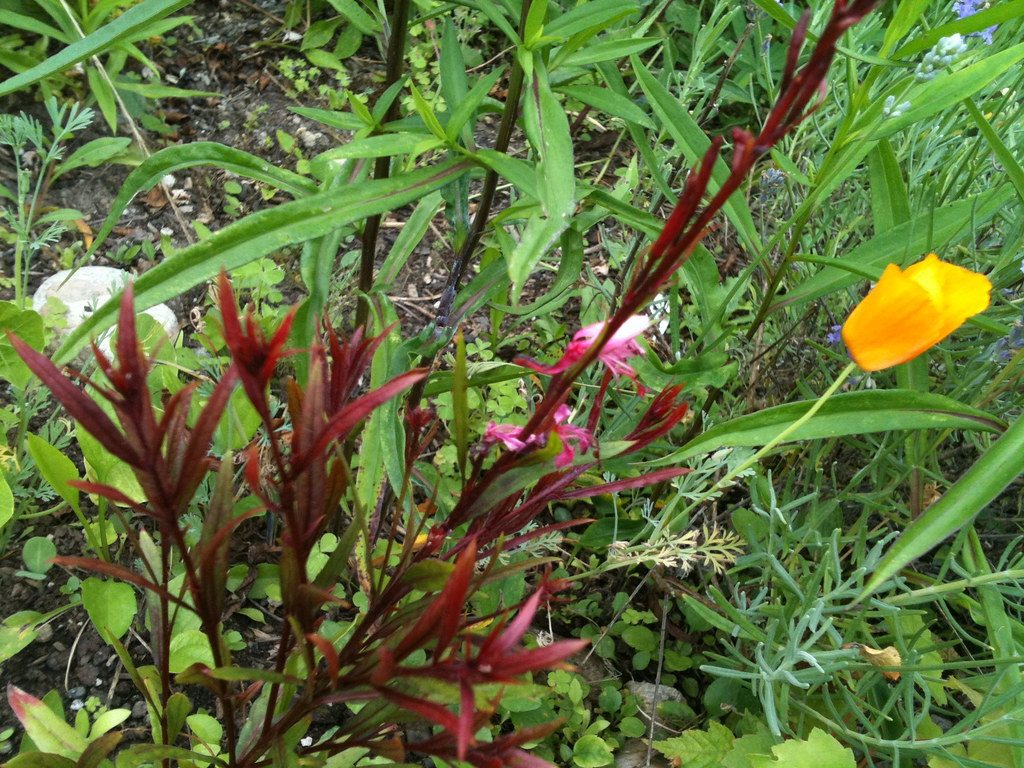One of the best things about our little garden bloggers’ group, SAGBUTT, is when new people stumble upon our meeting notices and decide to come and join us. Such was the case back in late March when a few of us ventured out in the rain to the Bellevue Botanical Gardens near Seattle for some time to chat and amble around between showers.
Jordan Jackson, owner of the Metropolitan Gardens garden design business, has been blogging about his garden and design services for a few years at Gardening in Cascadia and recently discovered some new ways of connecting with fellow gardeners and plant enthusiasts, such as Blotanical and SAGBUTT. His vast knowledge of botanical names alone is a great reason to check out his site, but his photos and showcasing of the variety of native and exotic ornamentals, especially perennials, are also well worth the clicks.
At our BBG visit, Jordan mentioned that he would be having an open garden in the near future, and invited us to come on out. His home garden, on a hillside overlooking Lake Washington in Seatle’s historic Mt. Baker neighborhood, issued a siren call that I could not resist.
Usually, I do not attempt to drag my 6 yr. old along on garden visits, especially those where I’d like to ask questions and not have to be on the alert for the potential trampling of precious plants. But since the other blogger in the family was out of town, it was bring her along or not go at all, so I chose to go for it.
As we pulled up to the curb, a small sign on the steep slope’s retaining wall announced the open garden hours, but first I had to check out the sidewalk garden. This parking strip is much narrower than mine, but is planted with one of the more unusual selections of tough but attractive plants I’ve seen in a long while.

Yes, that’s Ribes sanguineum ‘White Icicle’ out there for all to enjoy – here’s a close-up of the delicate flowers:

Another flowering currant, Ribes X gordonianum, keeps coming up lately – I think it’s going on my wish list as of right now:

Not every day do you just see one of these on the street (Cupressus arizonica ‘Blue Ice’):

Did you know that many species of Bottlebrush (Callestemon) are cold hardy in the Pacific Northwest? I didn’t! Thanks to Jordan, I now do. Here is a seedhead from last year’s blooming of Callistemon rigidus:

Across from the parking strip is a semi-casual, partly shaded narrow strip of charming low-growers. Lamium and Primula kisoana:

My new favorite spring ephemeral, Erythronium oreganum, whose name I did not know until Jordan provided it and helped me stick it in my brain by repeating it patiently until I got it:

There was probably a lot more down there of note, but I knew the clock was ticking on my daughter’s willingness to participate so we needed to head up the stairs. Maybe I can convince Jordan to do a post on his street garden one of these days, hint hint.
Our virtual tour of the upper garden will have to wait for another day, but I will tell you that the visit was enjoyable, revelatory, educational, and one that I hope to repeat in following seasons to see what else is growing there. Thank you to Jordan for the invitation, kind hosting, and plant name help!















































